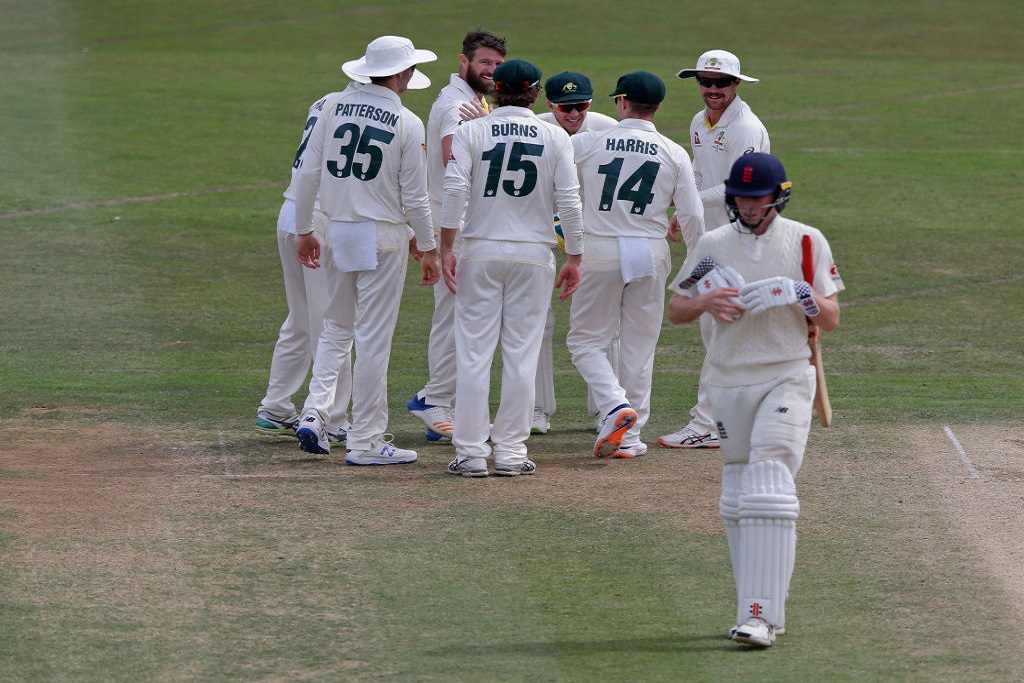Is It Finally Time for Two Division Test Cricket to Become a Reality?

CANTERBURY, ENGLAND - JULY 17: Australia team celebrate as Zach Crawley (R) of England Lions is dismissed off the bowling of Michael Neser of Australia Aduring the match between England Lions and Australia A at The Spitfire Ground on July 17, 2019 in Canterbury, England. (Photo by Henry Browne/Getty Images)
Hardy souls in the UK who wanted to catch the first ball of the first test between England and Sri Lanka would have had to be up for 4am, emerging bleary-eyed and pining for a cup of rather strong coffee.
Anyone who witnessed Sri Lanka’s desolation with the bat in the first innings of the match might have been left rubbing said eyes in disbelief. Fans would have been asking whether this test cricket, the absolute pinnacle of the sport, or a knockabout down at the local recreation ground?
Time and time again the Sri Lankans threw their wickets away. Wafting at long hops, the CricViz Analyst confirmed that Dom Bess’ five-wicket haul was almost disconcertingly unbelievable. Mindless reverse sweeps on a pitch offering some assistance to the spinners were also observed.
According to our Expected Wickets model, the deliveries Dom Bess has bowled today would, on average, take 0.18 wickets. #SLvEng
— The CricViz Analyst (@cricvizanalyst) January 14, 2021
The upshot is that England held a first innings lead at the end of the first day of the test, and from there were able to build upon a position of almost unassailable power.
The point, really, is that a touring test team playing in unfamiliar conditions aren’t usually heavy favourites on the second morning of a test to win the game, and, according to Space Casino, they are favourites for the second test as well. Many sportsbooks are barely offering a price on Joe Root’s men winning the series, such is their obvious dominance.
It’s for dead rubbers like this that the idea of two division test cricket has been floated around for a number of years. With the quality gap between the haves and the have nots seemingly widening, perhaps it’s time to revisit the notion once more.
A Shot in the Arm
Nobody takes any joy in the idea of separating international cricket, nor in preventing the likes of Sri Lanka, Bangladesh, and Afghanistan from trying their luck against the elite.
But test cricket is dying a slow and painful death in the face of a growing demand for the shorter formats of the game. The numbers are irrefutable, and something must be done to prevent test series’ from becoming irrelevant aside from the Ashes and the occasional mouth-watering clashes from around the globe.
There are 12 nations with test status, and these can easily be split into two categories.
The elite would include Australia, England, India, Pakistan, South Africa, and newly ranked number one side New Zealand. Then the rest, which would be an admittedly improving West Indies, Sri Lanka, Zimbabwe, Bangladesh, Ireland, and Afghanistan.
Sri Lanka have won just one of their last ten series against the elite sides, in our definition, with a number of those played on home grounds. It was 1999 when Zimbabwe last won an elite test series, Bangladesh are yet to get off the mark against the best in the business in more than two decades of trying. The West Indies’ lifting of the Wisden trophy in 2019 was their first major success in seven years.
⏪ HOW THE WEST INDIES WON IN 2019 ⏪
We rewind to 2⃣0⃣1⃣9⃣ and the last meeting between England and the West Indies in the Caribbean which saw the hosts win the Wisden Trophy 🏆 back…
👉 https://t.co/huIJ8FgZts #ENGvWI | 🏴🏝 pic.twitter.com/2kfZiY6FGS
— Sky Sports Cricket (@SkyCricket) July 7, 2020
The ICC has introduced its Test Championship to try and reinvigorate the longer form of the sport. While that will identify the ‘best’ team based on their parameters, it does very little to promote progression amongst the countries lacking in talent, financial muscle, or both.
Perhaps a two-division system, with one team promoted and another relegated could be successful. It would add jeopardy and meaning to test cricket, which is being threatened with inconsequence in the face of the razzmatazz of T20 competitions around the world.
Maybe then the 4am starts would truly be worth it.